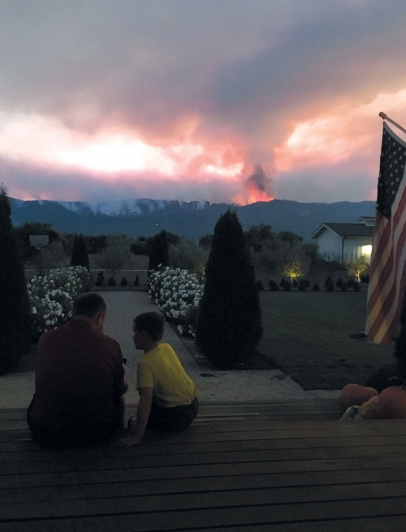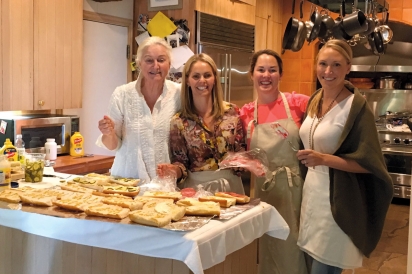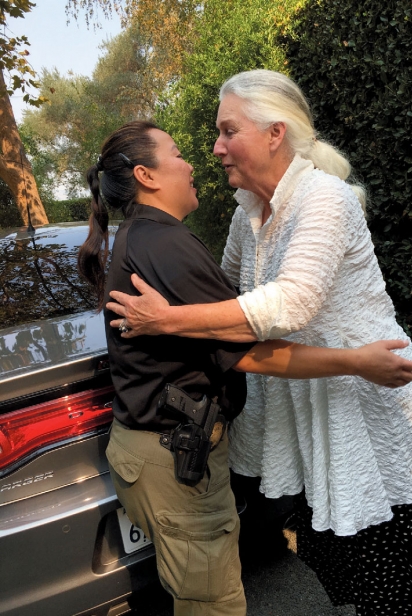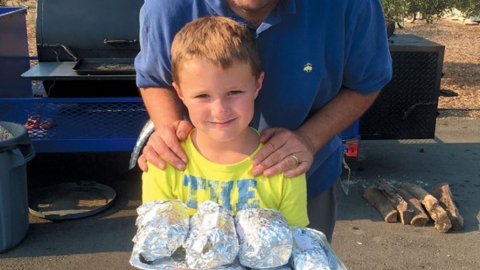Trial by Fire
WHEN THE TRAGEDY WAS AT ITS WORST, THE COMMUNITY BROUGHT ITS BEST
“It’s gone. It’s all gone.”
Five words forever changed me.
At 2:32am on Monday morning, October 9, my husband, Tuck, alerted me from my half-sleep that our ranch in Soda Canyon had burned. Earlier that night we had hosted a dinner party, which now seems like such a blissfully normal activity. After we had goodbyed, cleaned, put away, loaded and switched off , we wearily but happily climbed the stairs of our St. Helena home. We turned the corner to our south-facing bedroom window and saw the distant sky ablaze. Orange clouds billowed 20 miles away and my once-an-active-volunteer-firefighter-always-thinking-like-a-volunteer-firefighter husband shifted into gear.
“Soda Canyon is on fire.”
Soda Canyon lies on the southeast side of the Napa Valley, accessible from Napa by the Silverado Trail. Our ranch, one of many in the canyon, served as a weekend retreat, guest quarters for visiting family and friends, skeet shooting zone and entertaining space. Soda Canyon is a stark contrast to the Napa Valley. The canyon is raw, rocky. Chaparral grows thick. Gnarled oak trees hundreds of years old shade the land. Creeks gurgle. Snakes sun themselves. Deer, turkeys, quail, fox and wild pigs roam.
And the light beckons. To a new visitor it may seem that the view beckons . . . for at many points in the canyon’s hills, we see vineyards and the town of Napa in the foreground, then Carneros and the mouth of the Napa River, then the far mountains of Marin with Mt. Tamalpais lying in wisdom. The bridges gate the city lights and the fog, with her moody indifference, comes and goes as she pleases. On many occasions she clears the way for a sparkling city. But it is the light—full-spectrum greys, blues, pinks, purples and reds—which beckons a mindful mode of seeming solitude and stillness. The silence that allows the listening person to receive time, to witness life, to truly see that landscape and light are alive.
Some background: Tuck is a four-decade Californian, husband, father, grape grower, vintner, outdoorsman and also chief preparer for doom. His job is to ready our family for the worst. My job is to frame life with words, to assure our family that the worst is either (a) not coming, (b) not that bad, or (c) we can handle it. I am a native Southerner, almost 20-year Napa Valley resident, and tend to see life through a literary lens, a sense of awe and belief that calamities call for casseroles (or the foodie equivalent). October 2017 proved an Olympian challenge for us.
At 10:30pm that first night, Tuck loaded his truck with an axe, a chainsaw, shovels and his old fire gear and headed south. He sped down valley in eerie silence and at the intersection of Silverado Trail and Soda Canyon Road he noticed that no cars were driving out of the canyon. He turned and within a mile he found 30 cars stopped on either side of a downed tree, the air heavy with smoke and panic. A brave 20-something with a little two-wheel drive pickup was attempting to move the tree until Tuck (and his oversized pickup truck I routinely make fun of ) pulled the tree to the side of the road and cleared the way for cars to pass. Tuck was one of many tree-movers that night. One of many. That’s what we took away from this whole nightmare. One of many.
Tuck returned home that early morning, smoky, dirty and exhausted. He knew it would get worse before it got better. The perfect storm of wind, dry land and hard-to-access hills made the fires impossible to control right away. We prepped the generator, communicated our situation to faraway family and friends and prepared for the worst. Tuck, of course, had a plan. I did not. I followed newscasts that were (through no fault of their own) short on news. I took photographs. I Instagrammed (which, oddly enough, helped ease my fear).
When I looked outside, the phrase “Like Grant through Richmond” came to mind. (Translation for non-Southerners: It just kept coming from every angle.) Maps showed our Napa Valley (thanks to a hefty dose of exaggeration and fear on my part) could be encircled in the Atlas Fire to the Southeast, the Nuns Fire from the West, the Tubbs Fire from the North. And poor Sonoma! They were fighting the fight too! We were just one of many families who were threatened and scared. One of many.
After three days with the gnawing almost-certainty that our ranch had burned, Tuck finally gained access. As he rounded corners on Soda Canyon Road he saw the apocalyptic landscape we had imagined, clapped into reality by animal carcasses stopped in the midst of their manic escape. He discovered our ranch house in ashes, steel mangled and a metal roof askew. The patch of verdant grass nearby looked like a swatch of green fabric that someone dropped from above. A lemon tree was crispy, filled with charred lemons that I couldn’t help but imagine a chef might think would add just the right smoky citrus flavor to a fish dish. Down the hill, the oaks encircling our rocky entertaining area had burned above and around the large dining table—still standing and waiting to seat friends. Under the table a case of water, stashed for the next event, was completely intact. Our barn was also unscathed.
After three days without power, the meat in the deep freezer was cool to the touch. Cool to the touch. That’s exactly what we needed. The thawed meat was from two heritage pigs we bought at the Napa County Fair in August. The fair’s annual 4-H auction is rural America at its best. 4-H kids spend all year feeding and caring for animals to be sold at the auction and often use the monies raised to help pay for their education. When Tuck bought the hundreds of pounds of pigs, I asked, “How on Earth are we going to eat that?” The fires, and their first responders, brought our answer.
Tuck smoked the pigs (an ironic method of cooking, given the circumstances) for almost 24 hours. Within that time, we spread word of our plan to make sandwiches for first responders. The response was humbling:
From Meadowood: All the sandwich buns we have on property are waiting for you at the gate.
From Bouchon Bakery: 400 fresh buns will be ready at 4am.
From friendly young chefs: We’ll deliver coleslaw before our shift. (And coleslaw they delivered! Two bins the size of laundry hampers arrived.)
From Oakville Grocery: Do you need cold cuts too? Come and get as much as you want.
From as far away as Manka’s in Inverness: I hear you’re feeding first responders. Do you want 30 pounds of chili?
From neighbors: What time should I be there to assemble?
From friends: We can make some at our house too!
From strangers: Can we come help?
Four days and two pigs later, we had made hundreds of sandwiches. The sheriff ’s department arrived every few hours to deliver our fare to the firefighters on the front lines. But here’s the thing: We were only one of many such operations. One of many. Chef Thomas Keller showed up at the Saint Helena Fire Department to feed the hundreds based there. Food collectives in Sonoma and Marin made sandwiches that were so beautiful and delicious they belonged on magazine covers. And it just kept coming. Feeding operations continued until the fires were contained. As we worked alongside new friends and old friends we felt like we were making more than food. We hoped we were making fortification, strength and love. We knew we were giving thanks.
What made the fires so extraordinary in Napa and Sonoma were not only the scale, but the response. We, as a community, responded, as we do in our daily lives, with heart-felt hospitality. It’s what we do, and who we are. Cooking, preparing and offering our best made us feel normal in a time full of fear. It made us feel connected.
As we raise the third generation of grape growers in our family, Tuck and I often talk about the humility that goes hand in hand with farming. I learned recently that the Latin root of humility is humus (pronounced “HYOO-mus”), which means soil/land/earth. We believe that growing grapes and raising animals keeps us connected to the land, and indeed keeps us humble. When we lost our ranch and our other lands were threatened, that deep, visceral connection fueled us and many others to help. Our hearts ache for our neighbors who lost their land and we know how lucky we are that most of our land was spared. We are, after all, one of many families who fought for, grieved for, lived for and love our land. I’m reminded of Gerald O’Hara’s exhortation in Gone with the Wind: “Land is the only thing in the world worth workin’ for, worth fightin’ for, worth dyin’ for, because it’s the only thing that lasts.”









